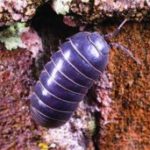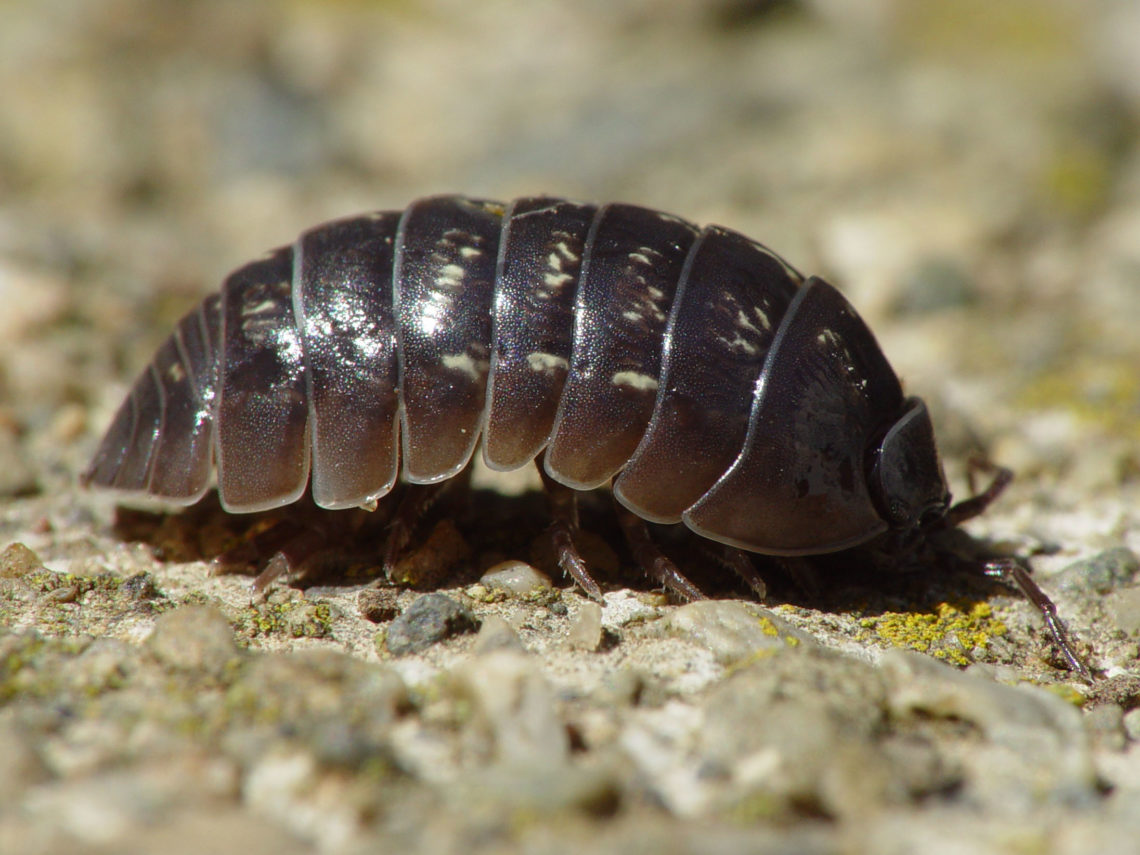Turns out a little bug we don’t think of much is one of the best protectors of soil ever imaginable. Read on to find out more!
Turn over a brick or a board lying in the yard and underneath you may find a collection of pill bugs scurrying about. Also known as “rollie pollies” or wood- lice, these grey-colored creatures can be found in many dark, moist environments feeding on decaying matter.
Actually, these critters are not bugs at all. They are crustaceans and more closely resemble crabs and shrimp, not insects. They are characterized by their ability to roll up into a ball when they feel threatened.
Breeding or collecting pill bugs may be an important practice for homesteading and gardening. The guts of these pill bugs contain a number of microbes that help the critter feed on dead, organic matter. By releasing mass quantities of pill bugs into a mature garden, one can be assured that dead plant matter is being properly broken down and returned to healthy soil.
 Pill bugs play an important role in the cycle of healthy plant life. They return organic matter to the soil so it can be digested further by fungi, protozoans and bacteria. This process produces a natural supply of nitrates, phosphates and other vital nutrients that plants need to thrive now and in future growing seasons.
Pill bugs play an important role in the cycle of healthy plant life. They return organic matter to the soil so it can be digested further by fungi, protozoans and bacteria. This process produces a natural supply of nitrates, phosphates and other vital nutrients that plants need to thrive now and in future growing seasons.
One very unique feature of these crustaceans is their ability to safely remove heavy metals from soil. For this reason, they are important for cleaning up soil pollutants such as lead, cadmium, and arsenic. In coal spoils and slag heaps, pill bugs also come in handy.
When they take in heavy metals like lead and cadmium, they crystallize these ions in their guts. The heavy metal toxins become spherical deposits in the mid gut. With this special cleanup capability, pill bugs survive in the most contaminated sites where most creatures can’t.
The magic of the pill bugs can reestablish healthy soil and prevent toxic metal ions from leaching into the groundwater. This means pill bugs are protecting well water from becoming contaminated while stabilizing soils.







69 Comments
T
This related abstract is interesting:
https://pubmed.ncbi.nlm.nih.gov/12475050/
John
Well of course, mercury, lead, cadmium etc are elements. They don’t get removed or changed by roly polys or anything else outside of a particle accelerator. They just get moved around.
Beck
It sounds like the pillbugs gather these elements into round objects in the midgut that keep those elements from leaching into the groundwater. They don’t change the elements, they just “fix” them in the soil so they can’t pollute. Yes, they are in the soil, like carbon is sequestered in the soil so it doesn’t become a part of the greenhouse gases. Hope this helps.
Mike
Once a pill bug dies the remains break down in the soil. The cool thing is that the metal doesn’t affect the bug, not that it actually eliminates these elements. Plants will still be able to absorb them once the material is ‘discarded’ and the coating breaks down.
Tim Prusaitis
Lead, cadmium, arsenic, etc, are atoms, not molecules. Molecules are atoms that have combines to make something new. Atoms have a certain number of attachment points that let them connect with other atoms to make molecules, by crystalizing the heavy metals the pill bugs are combining all those loose toxins in a way that keeps them from binding to lots of other atoms. As an oversimplified example, picture a lego block, it has 2 points where it can attach to other lego blocks to make a molecule. Now picture 10 loose legos, each with 2 attachment points, 20 total attachment points, but if you stick all 10 legos together you end up with a structure that only has 2 attachment points, it’s like 10 atoms that can only have the impact of one.
KenMcC
And another study says that when they get washed into water and eaten by fish, the fish take on the heavy metals and become our food…
Mark scott
And if a free range chicken eats a slater the heavy metals end up on your dinner table
PeteV
I’d like to read that study. Please site. From what I thought I learned, it was a LOT different. What I remember is that you can eat Oniscidae. The pill bugs don’t retain the heavy metals and toxins. They merely crystalize them and shit them out, and in that form they are not water soluble.
Em
Is that the study you dreamed about ?
Crawford Young
Ok you have to really pay attention to what the article claims to have found and what the article claims is the benefit of their findings.
The article claims this process of Rolie Polies digesting, concentrating and then CRYSTALLIZING prevents the metals from being leached into the ground water.
I’m guessing the CRYSTALLIZING PROCESS isolates or encapsulates the metals creating a barrier that’s not dissolved by water. I don’t think the crystallized metal would travel to our water supply since it’s probably heavy compared to water and would become sediment. If it does reach the water treatment plant it would be filtered out as a solid but at least it didn’t leach out into the water supply.
Crawford Young
The article states that once the Rolie Polie has the heavy metal concentrated in the gut it crystallizes the metal. So if the metal is crystallized does that make it safer or inert?
Dave Taylor
Increasing the size of the deposits makes it hard for plants to absorb them (and thus animals), because it dramatically reduces the surface area of a given amount.
Christine
But, this article doesn’t explain how to remove the pill bugs from the soil after they’ve become saturated with the toxic metals. That isn’t so easy. If they die where they are, the metals go right back into the soil.
Fred
Exactly! There is the error in reasoning.
Crystal Pearson
It’s not so hard to remove these guys. I breed them as clean up crew for bioactive reptile enclosures, when I clear containers I have to remove them from the container (which happen to be sweater boxes Under the entire length of my bed, currently . They actually overpopulate their enclosures at the moment. If you only want to remove them from where they are and don’t care about their safety, you can just bang whatever they are hiding on/under against whatever container you are moving them into. If they would be removing the isopods and don’t care about the brush/leaves/bark they are hiding under, they could remove all of it.
They likely remove the toxins by eating affected plant matter. If one of them dies, another eats it. They are detritivores.
No matter what, the amount of toxic chemicals removed from the soil would be repeated significantly.
jeffery a jantz
exactly
Earthdave
It says the beasts excrete the metals in a new form; they don’t retain them. But I still want to see what this ‘crystallized form’ is. If it is not organic and stable, then those metals will just cycle back in.
ngard0
another article say you can eat them they taste like shrimp. so what happens to the toxins if they are eaten ???
Susan Place
I have a hard time believing they would taste like shrimp. I would not eat them.
Jerry Cooper
Could I be involved in the test of this hypothesis?
KenMcC
Go for it.
Zack K
From the article at: https://www.columbiatribune.com/article/20150513/Lifestyle/305139937
“And they like heavy metal!
No, not the music! Scientists have found that pill and sow bugs can ingest a pretty good amount of heavy metal contamination in the soil. Once they take in the heavy metal, they concentrate it into small balls of heavy metal in their gut. This means that pill and sow bugs would have no problem living in an old mining area that might be contaminated with lead, cadmium, arsenic or other toxins. While this may seem like a great way to clean up contaminated land, the heavy metals do not actually leave the area. Instead they are just concentrated in the pill and sow bugs. Once the bugs die, those toxins would likely go back into the soil.”
Once again, it was another article without a source, although a seemingly more credible one, perhaps?
Eva
https://www.sciencedirect.com/science/article/abs/pii/S0269749109002115
Donna
Apparently as a youngster, I occasionally ate these!! If there were facial emoticons available, I’d be applying one here of varying horrified facial expressions, lol!!
Erin C.
Me too!
Kirk Van Nostrand
The comments here are better than the article.
Francine Schnereger
Please include sources when making scientific claims! No one should believe anything they read that doesn’t have sources. Please.
Paige Kinsman
Please, PLEASE learn how to spell ROLY POLY!!! Rollie is a famous pitcher’s first name. “Fingers” is his last name.
Bill Petronovych
“Bug” is a pretty general term, it dioesnt necessarily mean insect specifically. Arachnids, millipedes, centipedes… they can also be called bugs. The animal can have more than 6 legs.
Having said that, I’d always called them “pill bugs.” The term “wood louse” is mose likely to add to an already undeserved bad reputation.
Its really cool that they provide such a service. 😊
They need more recognition.
Jennifer
Actually if you ask an entomologist they will strenuously deny that the word “bug” applies to anything other than insects belonging to the order Hemiptera (two pairs of wings, three pairs.of legs. Pill “bugs” are actually isopods (7 pairs of legs).
Robert Heath
Where do they put the heavy metals? They have to put the heavy metals back into the soil in some form.
Tamara Baker
If the creature’s guts transform it into an inert compound that would be all the sequestration needed. But really, I would like to see the metals harvested from the bugs. If the metals can be recycled that would help prevent needing to mine for them.
PMMK
I don’t see anywhere in this article that says pill bugs transform heavy metals into inert substances. It merely states, “The heavy metal toxins become spherical deposits in the mid gut. ” Surely pill bugs poop. Surely they eventually die. What happens to all the toxic metal they have ingested?
Elizabeth
Correct. I couldn’t find any scientific paper that suggested any mechanism by which the metals are actually removed from the soil. Mercury, lead, cadmium and the rest are elements – they don’t “break down” without a nuclear reaction (which is certainly not happening in a pill bug’s gut). I suppose one could release many pill bugs into contaminated soil, then later painstakingly collect them and get rid of them elsewhere… but this hardly seems practical.
Jory Ferrell
Above, @Dave Taylor mentions that by creating larger spherical deposits, the total surface area of the metals is decreased. These makes them less reactive and slows down how quickly they dissipate into their surroundings. It’s similar to how aluminum becomes super reactive in nano-particulate form compared to larger particles around a millimeter in size. The question remains how much less dangerous these particles become to the environment as their surface area decreases…but that does make sense to me.
Kirk Van Nostrand
Correct! It’s not like these pill bug mid guts are infinite repositories of cadmium, etc. Where is the roly poly grave yard? Hello?
Lynn MD
Thank you, I studied Coleoptera and spend lots of my life telling people that. I live in England and it seems to have got worse since we have become more Americanised here. It makes me quite cross
Matt Cormons
That pretty photo you show of a blue pill bug, indicating infection with IIV-31 (Isopod Iridescent virus). Pretty but unusual.
Chris Oldt
The blue isopod looks like a “powder blue.”
mark eden
may be the crystallization is impervious to soil water break down
Philip
Maybe “soil water”…but not acid rain.
Chris Mills
I am just a life time garden, and avid composter but I’ve been guessing at my own theory here but not researched this yet. Im a big fan of the pill bug in my compost as a major farmer. At night I often see something in the pile when I turn it that floreses like a lightening bug when it’s smashed and smeared. I wonder if the pill bugs create a chemical deionization of some sort in their gut releasing a gas which could potentially render them non toxic. Just a guess. Most intestinal digestion occurs thru acid. Many batteries run release energy while combined an alkaline and acid charge. These effervescent streaks I see on the soil also have with them a tiny sting of slime too. So I thought it might be an accidentally smashed pill bug with caladium?????? Chris’s pill bug home made theory
Renee Piab
Gee, Chris! I really like your theory. It would be really cool if it could be put to the test: great if it turned out to be correct, wouldn’t it?
MKC
Hypothesis.
Vladimir Kelman
What happens to those crystallized deposits with accumulated heavy metals after creatures death? Do they stay inactive? Any studies on this topic?
Crystal Pearson
Isopods are detritivores, they eat dead organic material. If one does, another eats it.
Mark
Although it’s great to see the good they can do for protecting groundwater from heavy metals, etc., in areas that have been contaminated, I didn’t find data on how they are changing the ecosystem in the areas where the European species is introduced.
They are not all good for our forests in Oregon: a fungal root rot is killing some species of trees https://apps.fs.usda.gov/r6_decaid/views/port_orford_cedar_root_disease.html
Although it’s not stated in the link above, another transporter of the spores from the tree killing disease is this pill bug. We have forests where there is little to no human activity, and yet groves of white cedar are dead from this disease. The evasive pill bugs are nearly everywhere here now, by the billions. Not surprisingly, since it’s always damp and seldom freezes along the coast.
I’m not advocating that we have a mass extermination of the critters here, but I did want to shed light on some problems they may cause, at least the invasive guys.
Carol
Pill bugs DON’T remove heavy metals from the soil, and they cannot be used for soil remediation. They only carry the heavy metals around in their gut until they die, and then the heavy metals are released back into the soil again. The only way they could be used for remediation would be if they could all be removed from the area once they had ingested the heavy metals, and that would not be possible to do.
Marcus Schneck
I think your headline should be edited to something like “Previous Article Claims ‘Rollie Pollies’ Remove Heavy Metals From Soil, Protect Groundwater”
jai cee
I too was wondering what happened to the crystals when the little rolly pollies died. Sounds like the crystals just go back into the soil. Too bad the researcher did not look into that before putting out an article. I had always heard that these crustaceans were edible. I will no longer believe that as they are toxic.
M
https://link.springer.com/article/10.1007/BF00366076
Darlene Garvais
I no longer have institutional access to open the full article. Can you give a synopsis, or at least the conclusion?
Lars Finsen
It’s hardly relevant. Summary:
Lead and calcium nitrate in a potato base were fed to Porcellio scaber; three levels of each cation were used in a 32 factorial design experiment. The amounts accumulated were determined by atomic absorption spectrophotometric analysis of nitric acid digests of whole animals. Both cations increased markedly in the woodlice with increasing dosage and a clear correlation was found between the rates of uptake of the two.
Kathleen
But should I sweep them up when they get into my house and put them back outside or just flush them dii I em the toilet.
Joey Peterson
Of course you shouldn’t flush them down the toilet.
Terry
As you mentioned they are crustaceans and they are not alone in the heavy metal cleanup world. Lobsters also have that ability and are some of the best heavy metal clean up artists there are. The only thing is do not eat the innards (tomalley) as the liver is full of the heavy metal toxins the lobster filters out of the oceans. Crawdads also fall into this category of clean up artists ad there are probably other crustaceans that do as well.
Becky
Shrimp are good at cleaning up waste as well..that’s why people put them in tanks as cleaner species. (And why I will not eat shrimp or shellfish in general: nature’s garbage disposal).
Kristina Svare
I’m also missing scientific sources, which should always be referred to in the text as well as in a list of references. The one you linked to beneath Stefaan’s request is not accessible (except from the abstract), is from the eighties and seems to assess the pill bug as an indicator species without any mention of improved soils. Which sources did you use when writing the article? It’s an interesting subject.
Gary Munkhoff
Hi Kristina,
Thank you for your comment and for visiting our website. This article was published in our Summer 2017 issue and it was sourced from this website http://www.organicandhealthy.org. Since that time that website no longer exists. We did a Google search and found a similar article here: https://www3.northern.edu/natsource/INVERT1/Pillbu1.htm
Cheers,
Gary Munkhoff
Green Living Journal
Victor
The original paper says nothing about removing heavy metals. It talks about using pillbugs as a biological indicator of heavy metals. In other words, you can look at pillbugs to see if there is heavy metal contamination nearby.
Gary Munkhoff
Hi Victor,
Thank you for your comment and for visiting our website. This article was published in our Summer 2017 issue and it was sourced from this website http://www.organicandhealthy.org. Since that time that website no longer exists. We did a Google search and found a similar article here: https://www3.northern.edu/natsource/INVERT1/Pillbu1.htm
Cheers,
Gary Munkhoff
Green Living Journal
Daryl
When they die, do the heavy metals return to the soil as the bugs body breaks down?
Susan Place
That is an excellent question that I am unable to find a sure answer to. I did find this on Northern State University site which mentions them crystallizing the heavy metals.
https://www3.northern.edu/natsource/INVERT1/Pillbu1.htm
“Pillbugs are also of importance in sites such as coal spoils and slag heaps, which face heavy metal contamination. They are
capable of taking in heavy metals such as copper, zinc, lead and cadmium and crystallize these out as spherical deposits in
the midgut. In this way, they remove many of the toxic metal ions from the soil. Furthermore, owing to their high tolerance of
these ions, they thrive where other species cannot, and promote the restoration of contaminated sites by accelerating topsoil
formation. This in turn favors the establishment of plants that stabilize the soils by root formation. Stabilized soils reduce
problems of toxic dusts and the leaching of metal ions into the ground water.”
Erin Winslow
So? After the little critters have done their job, then collect them (maybe with a vetvac kind of vacuum-cleaner?) and process the crystals. The metals then could be recycled.
John Chambers
Actually, when they die, what usually happens is that they go into the stomach of the critter that killed them. Then the toxins are that critter’s problem. 😉
There are a lot of species known that sequester various sorts of toxins, and the ones that are the best at it tend to have fewer predators, for the obvious reason.
stefaan walleghem
Where is the scientific proof or study???
Green Living Journal
Hi Stefaan,
Thank you for your inquiry. Here is a link to one paper
Hopkin, S.P.; Hardisty, G.N.; Martin, M.H. (January 1986). “The woodlouse Porcellio scaber as a ‘biological indicator’ of zinc, cadmium, lead and copper pollution”. Environmental Pollution Series B, Chemical and Physical. 11 (4): 271–290. doi:10.1016/0143-148x(86)90045-5. ISSN 0143-148X.
Cheers,
Gary Munkhoff
Publisher
Nolan Bryce
Wow. Even the citation used is not a paper in support of the article, but a paper regarding the existence of heavy metals in certain areas of England.
Michael Ray Sirrine
LOL source of un-vetted drama
Date:
April 20, 2005
Source:
Johns Hopkins University
Summary:
A 22-year-old Johns Hopkins undergraduate and native of Ellicott City, Md. is playing an important role in ascertaining the role that terrestrial isopods — bugs commonly known as pillbugs, sowbugs and roly-polys — play in the recycling of nutrients in forest ecosystems.